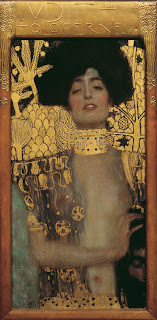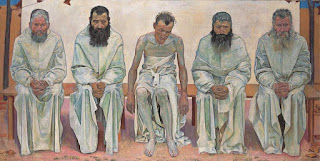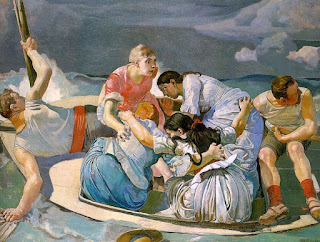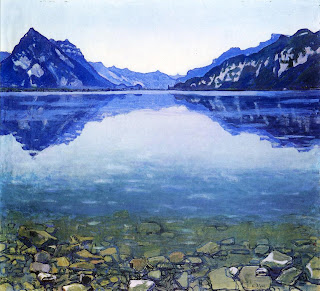I came across the following quote while researching my
previous entry which concerned Ferdinand Hodler and the Symbolist movement:
“Hodler’s portraits, on the otherhand,
are committed to the contingencies of the world. They refer to the unequivocal and the
evident, to the subject portrayed. All
that is left to discuss are historical details and painting technique.”
Tobia Bezzola
– “Landscape as Consensus Formula”
What I love about Art Historians is that they make the most
ridiculous statements and assert them so definitively. In the essay “Landscape as Consensus
Formula”, Bezzola dismisses most of Hodler’s oeuvre, promoting the premise that
only his landscapes and the Godé-Darel cycle remain relevant. He feels that his portraits, too concerned
with capturing the fleeting appearance of his sitters, could only interest us
for the circumstances that led to their creation or for their technical
execution. Obviously, Bezzola does not
adhere to the premise that technique is concept.
Hodler - Self Portrait - 1912
In my previous entry,
I disclosed how much I admire Hodler’s self portraits. The self portrait I selected to include above
exemplifies most of the traits that I appreciate in Hodler’s work. There is a certain élan in Hodler’s approach,
the confident way paint is applied to canvas in thick, impasto strokes, the way
the rapid, loose sketching in paint that initiated the portrait is never
obliterated, that corresponds to my assertion that, in spite of the many hardships
he suffered, Hodler maintained primarily an optimistic outlook throughout his
life. The brushwork dances over the
surface of the painting finding an intuitive rhythm of line and form. In some areas, the brushstrokes are short,
distinct and active, like bees gathered at a hive; in other areas, like the
white shirtfront, seemingly discordant tones are slurred together
successfully. Hodler’s unique palette conveys
an otherworldly luminescence that bathes form in an overall light. I get the feeling that, for Hodler, painting
was a performance in which every movement was decisive and rapidly executed, a
testament to his unparalleled skill. The
artist undoubtedly seeks to restrict detail, finding a shorthand approach to
translate visual reality. For instance,
the hair and beard are indicated very summarily, structure being determined by
two or three tones.
Hodler presents himself frontally and symmetrically, his
head filling the canvas. The artist is
addressing a momentary instant when a specific mood or emotion washes over
him. His face expresses bemused
surprise, as if he has just been confronted with some rather harsh criticism of
his work from an individual completely uninitiated into the mysteries of Modern
Art. It is not too big a stretch to
assert that his expression parallels that of the thrilled girl in Surprised by the Storm. There is something uniquely Swiss in this self
portrait. In the deft handling of the
paint, in the glowing overall coloration, in the image of a well dressed,
carefully groomed man expressing shock unconvincingly, I perceive a smug
confidence and satisfaction, affluence and wellbeing, and a droll sense of
humor.
Freud - Reflection (Self Portrait) - 1985
To further illustrate how technique cannot be extricated
from meaning, I will examine one of my favorite paintings, Reflection (Self Portrait) by Lucian Freud, in many ways the polar
opposite of the Hodler though quite similar in subject matter and
presentation. Technically, Freud is very
tentative. His paintings are executed in
layer upon layer of encrusted paint.
During countless sessions, Freud studies his sitter (in this instance,
himself), evaluating and reevaluating form, pose, coloration and light, seeking
a deeper penetration of his subject and a fuller understanding of
structure. Freud is very hesitant to
commit to a stance, repeatedly reconsidering every stroke he inflicts on the
canvas. Painting, for Freud, is a
laborious and unrelenting process of examination and documentation. Ignoring the subject matter, the piercing
gaze of the artist and the unsettling lack of clothing and focusing solely on
technique, it is unmistakably evident that the Freud has to be a very different
painting from the Hodler.
Portraiture is a long established genre which at its worst
can get real tedious and musty. But innovative
masters have regularly proven that the genre continues to be relevant. Just taking a look at the two following self
portraits, one by the photorealist Chuck Close and the other by the
expressionist Alice Neel, will give you an idea of how much potential
portraiture still offers.
Close - Big Self Portrait - 1967
Neel - Self Portrait - 1980
I must acknowledge that I love self portraits, which may
explain why I paint so many myself.
There is the issue of availability.
Who else would pose for hours in a poorly ventilated studio? And who else would be able to strike the
precise pose required and set the desired expression effortlessly session after
session? Most importantly, painting
yourself frees you from a dialogue with the model, that intrusion of another
voice or perspective which inevitably, no matter how much of a steely renegade
you believe yourself, reverberates within the artist’s mind. So, I have a long history of painting myself
and thought it might be interesting to provide a sampling of a handful of my self
portraits.
Wickham - Self Portrait - Oil on Canvas - 1980 - 30" X 24"
Under the influence of expressionism, I painted this
elemental image of myself, tanned, bearded and long-haired, in thinned washes
of earth tones, blue and black. The
quick rendering of my features in dark umber is very apparent in the finished
painting; the brushwork is loose and intuitive; detail is minimal.
Wickham - Self Portrait - Oil on Canvas - 1981 - 30" X 24"
I included the two previous self portraits in an early show
and a reviewer felt that they were contradictory, that I must be bipolar or
emotionally confused since one painting portrayed a disturbed wild man and the
other an urbane and cultured gentleman.
Without a doubt, I was in a better place when I painted the second self
portrait, but I certainly don’t find the image soothing or reassuring. I was perplexed by the reviewer’s
comments. Both works are essentially
expressionist in vocabulary and depict the artist assuming a confrontational
and troubling attitude.
Wickham - Self Portrait with Deer Hoof -Oil on Canvas - 1983 - 48" X 40"
This painting was intended as one panel of a diptych based
on an absurdist reinterpretation of the Annunciation. The work was never completed, unfortunately,
because my intended model for the Angel Gabriel became uncomfortable with the
project and I didn’t press for her continued participation. Strangely enough, the one complete panel stands
very well on its own merits.
Wickham - Self Portrait - Oil on Linen - 1988 - 18" X 16"
For a period of several years, I only painted abstractly, an
approach that revitalized my art and produced a satisfying body of work, but
eventually painting in this manner became conventionally confining and came to
a dead-end. It was very difficult for me
to walk away from abstraction, and for quite a while I created paintings that
were neither fish nor fowl, toying with clearly recognizable imagery that was presented
in a truncated or mutilated fashion and executed in a painterly expressionist
technique. These paintings, without
exception, are failures, but they did reintroduce me to the possibilities of
representational imagery. I certainly
had no intention at that time to become a figurative or realist artist, and yet
slowly the work evolved in that direction.
This self portrait comes from this strange period when I was a little
lost, just putting my toe in to test the representational waters, so to speak,
but uncommitted to any specific approach.
Vestiges of my abstract experience are apparent in the patterned and
energetic brushwork, the unconventional color combinations, the harsh
transitions between lights and darks and the clearly visible, intensely colored
underpainting.
Wickham - Self Portrait - Oil on Canvas - 1996 - 14" X 12"
I had just gone through a long period of experimentation
during which I painted small frontal portraits in heavily built-up layers of
impasto when I started this self portrait which ultimately signaled the end of
the series. Using thin transparent
glazes of delicate color, I depicted myself in three quarter perspective, the
result being about as close as I’ve ever gotten to embracing a photorealist
technique. This happens with me
frequently. I will tenaciously pursue
one avenue of exploration, setting circumscribed restrictions on technique,
subject matter and approach, painting one image after another for months or
even years, until I have exhausted myself, garnering whatever disclosures the
experience offers. Without
premeditation, a painting that violates all of the restrictions I have been
conscientiously following will cap off the series, usually resulting in a very
successful work that suggests a multitude of possibilities for future progress.
Wickham - Self Portrait - Oil on Canvas - 2000 - 54" X 30"
I’ve never been an artist to flatter a sitter which at times
has led to some uncomfortable moments when a final viewing has met with stony
silence from my model, usually an unpaid volunteer. I recall while in Grad School
Wickham - Self Portrait - Oil on Canvas - 2002 - 16" X 12"
Painted in my studio under a bare incandescent bulb, with
ribbons of black cloth draped in a cocoon around my head, this self portrait
achieved a sense of light as a tangible substance. It was executed in oils, layer upon layer
applied over numerous sessions in various thicknesses from impasto to viscous
to dilute. When completed, the surface
finish ranged from matte to glossy, making it difficult to view as a whole, in
particular, contesting the sense of light I was struggling to capture in the
work. I placed it aside for a number of
years before pulling it out one day to discover that in drying it had achieved
the desired effect.
Wickham - Self Portrait with Camera - Oil on Canvas - 2011
The lighting in my bathroom, a wall bracket of frosted
globes combined with an overhead ceiling fixture, creates a subtle suffused
frontal light contrasted with a strong halo effect which has interested me for
years, but, as for initiating a painting, compositionally I always drew a
blank. One afternoon I noticed that the
two mirrors in the room, one over the vanity and the other set in the medicine
cabinet, were facing each other and created an effect I first witnessed as a
young boy seated in the raised chair at Pete’s Barbershop: the mirrors
contained a repetition of infinite images of me and my surroundings receding
into nothingness. In my bathroom, I
particularly liked that the reflections created multiple framing devices that
bordered my head, creating a confusing and disjunct space. So I grabbed my Nikon and took a series of
photographs which I used to create the self portrait included above. I felt a sort of confessional relief showing
the camera in the painting, as I regularly use photographs as a resource for my
work without the imagery and paint handling reflecting this. Though the debate over whether it is
legitimate to use photographs as a resource for painting or plaster casts for
sculpture is long dead, having been trained to paint and draw from life, I
still suffer a little guilt.
Technically, as has been the case in recent years, I strove to allow the
painting to form organically, utilizing whatever means makes sense for the form
or texture or surface or light effect that I endeavor to replicate. I still utilize an underpainting to heighten
color vibration in the finished work, though the hues are much more subdued
than those I used in the past. I
definitely apply fewer layers and use less paint than ever before, not for the
sake of speed or economy but to assert an authenticity of approach.
I really found it fascinating to select and evaluate this
series of my own self portraits, to witness my growing older while observing my
stylistic evolution. To keep the length
of this entry reasonable, I had to limit my selections, excluding some
satisfying works in the process.
Hopefully, I can revisit the theme in the future, and perhaps, by that
time, I will have produced a new self portrait or two.

-1985.jpg)





















